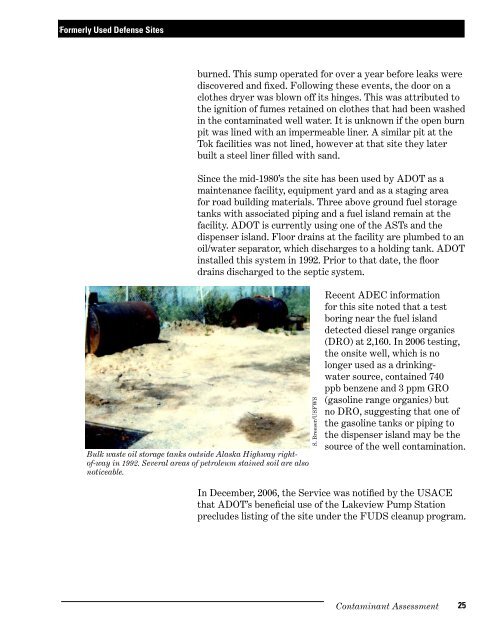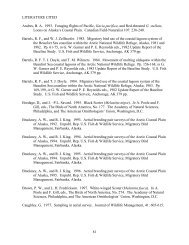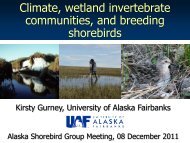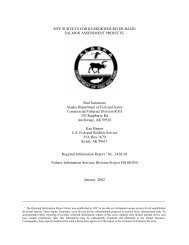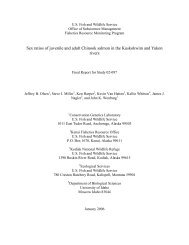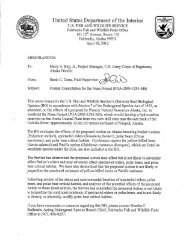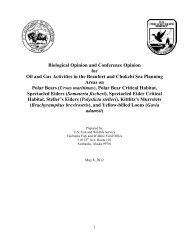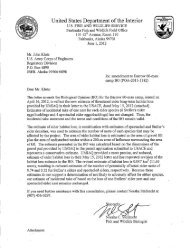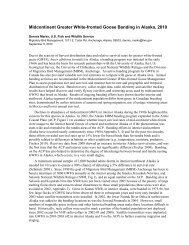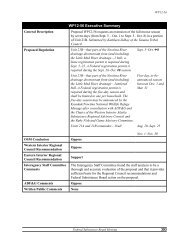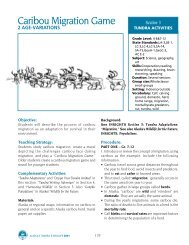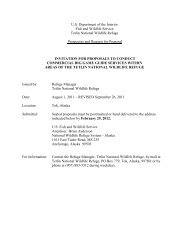Tetlin National Wildlife Refuge - USFWS Alaska Region - U.S. Fish ...
Tetlin National Wildlife Refuge - USFWS Alaska Region - U.S. Fish ...
Tetlin National Wildlife Refuge - USFWS Alaska Region - U.S. Fish ...
You also want an ePaper? Increase the reach of your titles
YUMPU automatically turns print PDFs into web optimized ePapers that Google loves.
Same Formerly as the Used text Defense heading Sites<br />
burned. This sump operated for over a year before leaks were<br />
discovered and fixed. Following these events, the door on a<br />
clothes dryer was blown off its hinges. This was attributed to<br />
the ignition of fumes retained on clothes that had been washed<br />
in the contaminated well water. It is unknown if the open burn<br />
pit was lined with an impermeable liner. A similar pit at the<br />
Tok facilities was not lined, however at that site they later<br />
built a steel liner filled with sand.<br />
Since the mid-1980’s the site has been used by ADOT as a<br />
maintenance facility, equipment yard and as a staging area<br />
for road building materials. Three above ground fuel storage<br />
tanks with associated piping and a fuel island remain at the<br />
facility. ADOT is currently using one of the ASTs and the<br />
dispenser island. Floor drains at the facility are plumbed to an<br />
oil/water separator, which discharges to a holding tank. ADOT<br />
installed this system in 1992. Prior to that date, the floor<br />
drains discharged to the septic system.<br />
Bulk waste oil storage tanks outside <strong>Alaska</strong> Highway rightof-way<br />
in 1992. Several areas of petroleum stained soil are also<br />
noticeable.<br />
S. Breeser/<strong>USFWS</strong><br />
Recent ADEC information<br />
for this site noted that a test<br />
boring near the fuel island<br />
detected diesel range organics<br />
(DRO) at 2,160. In 2006 testing,<br />
the onsite well, which is no<br />
longer used as a drinkingwater<br />
source, contained 740<br />
ppb benzene and 3 ppm GRO<br />
(gasoline range organics) but<br />
no DRO, suggesting that one of<br />
the gasoline tanks or piping to<br />
the dispenser island may be the<br />
source of the well contamination.<br />
In December, 2006, the Service was notified by the USACE<br />
that ADOT’s beneficial use of the Lakeview Pump Station<br />
precludes listing of the site under the FUDS cleanup program.<br />
Contaminant Assessment<br />
25


